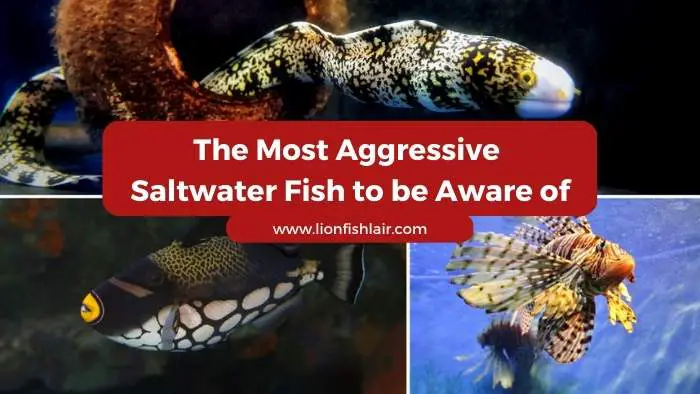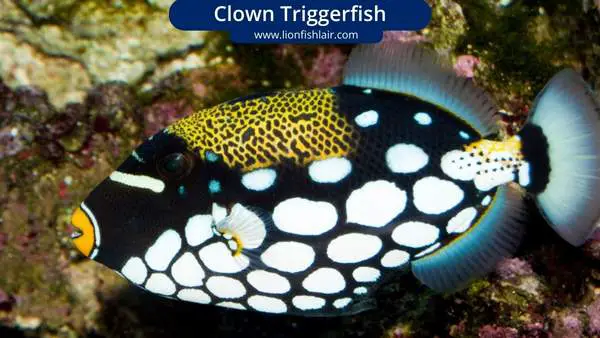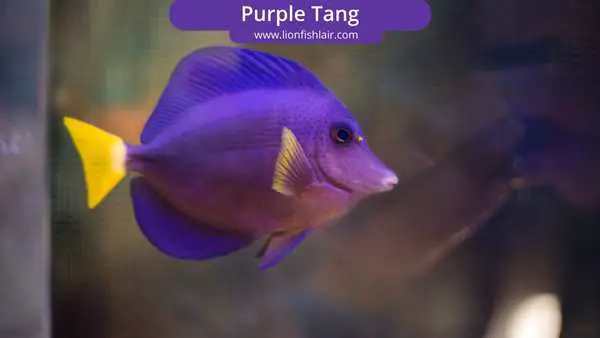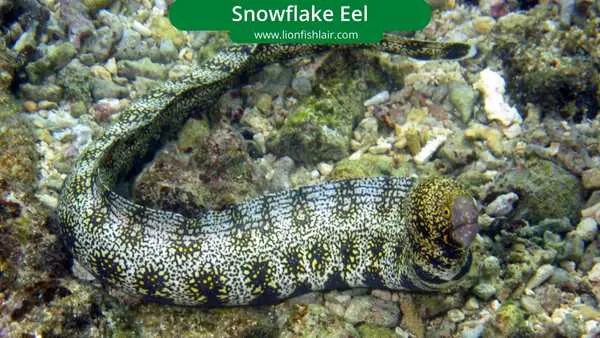As a saltwater aquarium owner, you are most likely a fan of beautiful, unique, and colorful fish, which can only be unlocked through owning saltwater fish. Unfortunately, much like in real life, some of the most beautiful are the most dangerous, or in this case, aggressive.
Some of the most gorgeous saltwater fish can also be some of the most vicious ones, and in this guide, I will be taking you through my list of the most aggressive saltwater fish picks.

Owning aggressive fish is certainly a challenge, and there are many hobbyists that enjoy taking it on. Those with experience are able to do so successfully.
However, if you are just starting out or have a moderate level of experience and wish to keep a harmonious saltwater fish community, I would recommend avoiding these fish right away.
What Makes an Aggressive Saltwater Fish?
Aggression in fish is different on a case by case basis, with different motivations and factors playing huge roles in why they behave in this way. For example, aggressiveness in fish can be seen in the relationship between prey and predators, when one fish is seen as food to another.
Another example would be territorial aggression – there are some fish that tend to occupy a certain area/territory within their tank, and if any other fish or invertebrates enter the proximity, it could be a short life for them.
Spacing also causes problems with fish being aggressive, you must ensure that your aquarium is of a sensible size - most of the fish on this list would do well in a 150 gallon saltwater aquarium.
Something else that triggers aggression in fish is resources – fish will fight over valuable resources and food that they gather. And lastly, there are many fish that start becoming aggressive during and after breeding/spawning, to protect their fry.
For more in-depth information on each of these causes of aggression, we have detailed everything near the end of this article.
Top 5 Most Aggressive Saltwater Fish (List)
Aggressive fish might be a challenge to handle, but this isn’t to say that you cannot house them with other fish, in fact, you certainly can do, and they will do really well, but do so with caution.
Each fish on our list will have its own tank requirements and informational summary, which includes potential compatible tank mates.
Clown Triggerfish (Balistoides conspicillum)
Triggerfish are one of the most visually stunning fish in the world, however, they are super territorial and do not shy away from confrontation. They are awesome to watch and to keep, offering a realistic challenge to more advanced saltwater fish keepers.

Clown triggerfish overview:
- Max size: 20 inches (50.8 cm).
- Max age: 10+ years.
- Water temperature: 72 to 78°F (22.2 to 25.5°C).
- Suitable tank mates: large pufferfish, groupers, tangs, angelfish, lionfish.
On the surface, they seem like shy and timid fish, that keep themselves to themselves. However, there is a more sinister side to them, especially once they start growing bigger and stronger.
Once they are of a mature age and size, and are comfortable in your aquarium, they will begin to move things around in your tank, as well as biting at corals and live rock.
Not only this, but they will gobble up any crustacean or invertebrate that is residing in your tank too. They are hungry and growing carnivores that will eat pretty much anything they can sink their ridiculously large and sharp teeth into.
The biggest piece of advice I could give with regards to these triggerfish is to avoid keeping them with any expensive small fish or invertebrate, because they will likely go missing overnight.
Lionfish (Scorpaenidae)
It wouldn’t be an aggressive fish list without mentioning our favorite fish of all time – the lionfish! These guys are absolutely insane-looking, closely resembling what we would imagine extra-terrestrial life to be like.
However, they are aggressive, invasive, and hungry carnivores that will wreak havoc on your saltwater fish community if they are not treated correctly.

Lionfish overview:
- Max size: 18 inches (45.72 cm).
- Lifespan: 18+ years.
- Water temperature: 72 to 78°F (22.2 to 25.5°C).
- Suitable tank mates: blue tang, maroon clownfish, clown triggerfish, harlequin tuskfish, pantherfish.
They have seriously venomous spines that can cause an abundance of issues for human-beings, let alone other fish. There are many different lionfish species that range in size, patterns, and coloration, however, the one thing they all have in common is their nastiness. Any fish that can fit in their mouths will likely become a meal, and if another fish enters their territory, I wish them luck!
A good thing with lionfish is their hardiness and adaptability, as well as lack of natural predators, which explains why they are becoming an invasive species in the wild. Most people tend to keep a singular lionfish on its own, which is a safe bet, but you can keep them with other fish, just ensure they are compatible and have plenty of places to hide safely away from your lionfish.
Purple Tang (Zebrasoma xanthurum)
Surgeonfish, or tangs might be one of the most popular fish species today, probably with some credit going to “Finding Nemo” and “Finding Dori’s” for putting the famous blue tang on the map!
Anyway, these guys might seem like lovely, cute, and beautiful fish, but they do have a pretty dark side to them, especially the purple tang subspecies. Also, all surgeonfish own “scalpels”, which are located on their tail and will pierce skin with ease, should they feel threatened.

Purple tang overview:
- Max size: 10 inches (25.4 cm).
- Lifespan: 18+ years.
- Water temperature: 72 to 78°F (22.2 to 25.5°C).
- Suitable tank mates: blue tang, cardinalfish, larger clownfish, wrasses.
Purple tangs will usually spend their days eating and swimming around your tank, picking on smaller fish that they cross paths with. If your aquarium is too small to house them, then their regular aggression will begin to intensify, which is worrying for everyone involved. Honestly, you should only acquire one of these tangs if you have enough space for them.
Unlike most of the fish on this list, purple tangs are not carnivores, and in fact, they are herbivores, feeding primarily on macroalgae and other greens. So, ensure that you have enough in your tank to satisfy your purple tang – they get even worse when they haven’t been fed for a while!
Snowflake Eel (Echidna nebulosa)
It probably does not come as much of a surprise to see a species of eel enter the list, considering how menacing and scary their faces and body shapes are! Not only do they have a scary appearance, but their behavior is also pretty darn aggressive too, especially when they grow older and bigger.

Snowflake eel overview:
- Max size: 25 inches (63.5 cm).
- Lifespan: 15+ years.
- Water temperature: 72 to 78°F (22.2 to 25.5°C).
- Suitable tank mates: Lionfish, triggerfish, tangs, wrasses, other snowflake eels.
These eels in particular have an incredibly unique pattern and coloration that they display, with eye-catching markings and colors that resemble, well, you guessed it, snowflakes!
Whilst some of the larger eel species are more aggressive and dangerous than these, it is important to note that they are still in the same family, and will catch and eat any fish that will fit inside their mouths.
Something to note is that their eyesight is very poor too, which often leads to unintentional casualties for some of your saltwater fish community members and even your fingers if you are not careful.
My recommendation for keeping these guys is that you should know what you are doing and have PLENTY of experience dealing with large, aggressive, saltwater fish. Also, try to provide them with as many hole/cave-like spaces for them to hide in and feel more comfortable in.
Different Types of Saltwater Fish Aggressiveness
As mentioned at the beginning of this guide, there are a few different types of aggressiveness that I have found in saltwater fish. I have categorized them each and explained in a summary what triggers a fish to behave in that specific kind of way.
Predatory Aggression
This one is fairly simple, when a carnivorous fish that is big enough to engulf another fish is hungry and spots a small enough fish to fit in its mouth, nine times out of ten that big hungry fish will eat the small one! It might sound somewhat barbaric, but this is life, and how the food chain works.
If you didn’t realize that you had a super hungry carnivorous fish that enjoys the taste of others, then this could be the reason why so many fish are going missing.
The best solution for an aggressive predatory fish is to provide them with a healthy diet that consists of live foods, which gives them the same feelings as if they were hunting the live prey themselves in the wild.
Territorial Aggression
This form of fish aggression is probably the most common one, and tends to occur when a notoriously territorial fish has established their own area within your aquarium and as soon as another fish or living being enters, they will protect it with their lives!
Fortunately, the solution is rather simple. If you are planning on keeping territorial fish with more chilled out fish, then you should ensure that you add the trouble-makers last because all the peaceful fish were established within the tank first and have established their territories first.
Food-Related Aggression
Underfeeding your fish tank not only will cause significant health issues for some of your fish that require a full and balanced diet to live healthily, but it also causes aggressiveness.
Think about it, when you are hungry for a long period of time, you can become a little cranky. People call this being “hangry”, a mixture of hungry and angry – well this happens to fish as well.
Not only do your fish begin to behave more aggressively when they are hungry, but they will fight and compete for food whenever you do decide to feed them, which makes matters even worse! All of this will also result in stressed-out fish, and a stressed fish is much more likely to become ill or pick up a nasty disease or parasitic infection!
Aggressive Fish – Final Thoughts
The fish that I have been discussing in this guide are aggressive, yes, but they are also manageable if you have the right knowledge, plan, and experience in keeping saltwater fish.
I would suggest that you do not shy away from owning one, if you are up for a challenge, but I think that it is incredibly important to know the negatives of owning an aggressive fish, or more specifically one of these aggressive fish, and how you can turn that into a positive!
